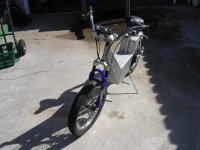albie
100 W
glad you sorted out your issue....
sometimes somthing as simple as either shortening wires or running thicker wires usually solves alot of heating / voltage drops.
i had the same issue when I upgraded from 24 to 36v. The wires on the pack initially were to thin and heating up (just before the point where the plastic started to melt). A quick trip to the local electronics store (jaycar) resolved that by getting nice thick wires (and subsequently trimmed to a length required.
sometimes somthing as simple as either shortening wires or running thicker wires usually solves alot of heating / voltage drops.
i had the same issue when I upgraded from 24 to 36v. The wires on the pack initially were to thin and heating up (just before the point where the plastic started to melt). A quick trip to the local electronics store (jaycar) resolved that by getting nice thick wires (and subsequently trimmed to a length required.














